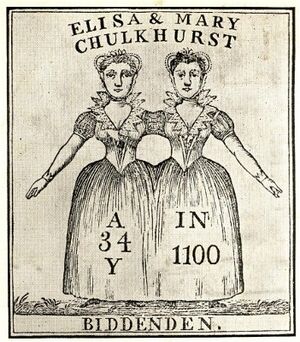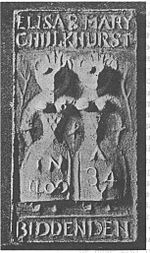Biddenden Maids facts for kids
Mary and Eliza Chulkhurst (also spelled Chalkhurst) are famous as the Biddenden Maids. They were supposedly conjoined twins born in the village of Biddenden, England, in the year 1100. The story says they were joined at both the shoulder and the hip. They lived for 34 years. When they died, they are said to have given five pieces of land to their village. These lands became known as the Bread and Cheese Lands. The money from these lands was used to give food and drink to poor people every Easter. Since at least 1775, this special gift has included "Biddenden cakes." These are hard biscuits with a picture of two conjoined women on them.
Even though the food and drink have been given out since at least 1605, the story of the sisters wasn't written down until 1770. At first, no one knew their names. Early pictures on the cakes also didn't show names. It wasn't until the early 1800s that the names "Mary and Eliza Chulkhurst" were first used.
Some historians, like Edward Hasted, thought the story was just a folk tale. They believed the picture on the cake was meant to show two poor women, and the story of the twins came from people misunderstanding the picture. Another historian, Robert Chambers, thought the legend could be true but probably wasn't. Despite these doubts, the story became very popular in the 1800s. Many visitors came to Biddenden every Easter. Later, some historians thought the twins might have really lived, but perhaps in the 1500s instead of the 1100s, and maybe they were only joined at the hip.
In 1907, the Bread and Cheese Lands were sold for houses. The money from this sale helped the annual food gift grow a lot. Now, widows and older people in Biddenden receive cheese, bread, and tea at Easter, and money at Christmas. Biddenden cakes are still given to the poor each Easter and are also sold to visitors as souvenirs.
Contents
The Legend of the Biddenden Maids
According to the old stories, Mary and Eliza Chulkhurst were born in Biddenden, Kent, in 1100. Their parents were quite well-off. The twins were said to be joined at both their shoulder and hip. They grew up together, and it's said they often argued.
When they were 34 years old, Mary Chulkhurst suddenly died. Doctors offered to separate Eliza from her dead sister. But Eliza refused, saying, "As we came together we will also go together." She died about six hours later.
In their wills, the sisters supposedly left about 20 acres of land in Biddenden to the local church. The money earned from this land was meant to provide bread, cheese, and beer to the poor every Easter. This is why the lands became known as the Bread and Cheese Lands.
How the Tradition Started
The church leaders in Biddenden continued to give out the annual food gift from the Bread and Cheese Lands. Records show that in 1605, this custom was stopped for a short time because of a visit from a church official. The ceremonies had sometimes become too noisy and disorderly.
In 1645, the local priest tried to claim the Bread and Cheese Lands for himself. But after a legal case, the charity won in 1649. The charity continued to own the lands and give out the Easter food. People who spoke in court mentioned that the lands were given by two women "who grew together in their bodies." But they didn't say the women's names.
By 1681, the yearly food distribution was causing so much "disorder" that it was moved from inside the church to the church porch.
By 1770, the annual gift was given out right after the Easter church service. The money from the lands had grown, and a lot of food was given away. By this time, in addition to bread, cheese, and beer, hard bread rolls called "Biddenden cakes" were also given. These cakes had a picture of the sisters on them and were sometimes thrown to the crowds from the church roof. The cakes were flat, hard, and made of flour and water.
Where the Legend Came From
The first written story of the Biddenden Maids appeared in a magazine in 1770. This story said the twins were joined only at the hip and lived to be quite old. It also said their names were not known. The writer believed the story was true. At this time, the story didn't mention their birth year as 1100 or the name Chulkhurst. These details first appeared in a printed paper sold in 1790. Pictures of Biddenden cakes from this time show two women, possibly joined, but no names or dates.
Historian Edward Hasted wrote in 1798 that he didn't believe the legend. He thought the Bread and Cheese Lands were given by two women named Preston. He also said the Biddenden cakes only started having the image of two women around 1748. He believed the figures were meant to show "two poor widows" who were helped by charity. He called the story of the conjoined twins "a common folk tale."
Many people, including historian Robert Chambers, generally thought the story was a myth. In 1869, a letter to a medical journal pointed out that surnames weren't used in Kent in the 1100s. It also suggested that the number "1" and "5" could be easily mixed up in old handwriting, meaning the birth year might have been 1500.
The Charity Grows
As the yearly food gift became bigger, the Easter event grew more popular. In 1808, a paper with a picture of the twins and their story was sold outside the church. This was the first time the names "Eliza and Mary Chulkhurst" were mentioned. Clay copies of Biddenden cakes were also sold as souvenirs.
The paper from 1808 described the twins: "A Short but Concise account of Eliza and Mary Chulkhurst who were born joined together by the Hips and Shoulders In the year of our Lord 1100 at Biddenden in the County of Kent, commonly called The Biddenden Maids The reader will observe by the plate of them, that they lived together in the above state Thirty-four years, at the expiration of which time one of them was taken ill and in a short time died; the surviving one was advised to be separated from the body of her deceased Sister by dissection, but she absolutely refused the separation by saying these words—'As we came together we will also go together,'—and in the space of about Six Hours after her Sister's decease she was taken ill and died also. By their will they bequeath to the Churchwardens of the Parish of Biddenden and their successors Churchwardens for ever, certain Pieces or Parcels of Land in the Parish of Biddenden, containing Twenty Acres more or less, which now let at 40 Guineas per annum. There are usually made, in commemoration of these wonderful Phenomena of Nature, about 1000 Rolls with their Impression printed on them, and given away to all strangers on Easter Sunday after Divine Service in the Afternoon; also about 500 Quartern Loaves and Cheese in proportion, to all the poor Inhabitants of the said Parish."
In the 1820s, a new story claimed that the sisters were buried near the rector's pew in Biddenden church. By 1830, Biddenden was crowded with visitors every Easter. The large crowds often became unruly. Because of this, the food distribution was moved from the church to the workhouse. But the crowds still caused problems. In 1882, the church stopped giving out free beer to try and control the crowds.
In 1900, an expert named George Clinch studied the Biddenden Maids. He looked at the clothes shown on the Biddenden cake molds. He thought the style of dress was from the 1500s. This fit with the idea that the twins lived "two hundred and fifty years ago," as reported in 1775. He thought the "1100" date on the cakes might have originally been "1500."
Belief and Doubts
Most drawings and cake designs show the twins joined at both the hip and the shoulder. While it's possible for twins to be joined in more than one place, no known case of twins joined in this way has ever lived.
Clinch believed the twins might have existed but in the 1500s, not the 1100s. However, no books or journals from the 1500s mention them. If conjoined twins had lived to adulthood in England during that time, it would likely have been written about.
In 1895, a surgeon named J. W. Ballantyne looked at the Biddenden Maids from a medical point of view. He thought they might have been pygopagus twins, meaning they were joined at the pelvis. Pygopagus twins often put their arms around each other's shoulders when they walk. Ballantyne thought this might explain why drawings showed them joined at the shoulders. Other pygopagus twins, like Millie and Christine McCoy, lived long lives and had successful careers.
Jan Bondeson (a writer on medical history) suggested that while the names "Eliza and Mary Chulkhurst" might have been added later, the idea that the twins existed and were born around 1100 can't be completely dismissed. He noted that old Irish records from around 1100 mention conjoined sisters. He also pointed out that there would be no reason for the villagers in the 1700s to make up the story. He agreed that the idea of them being joined at the shoulder might be a misunderstanding of the cake figures.
Today's Tradition
In 1907, the Chulkhurst Charity joined with other local charities. It became the Biddenden Consolidated Charity, which is still active today. The Bread and Cheese Lands were sold for housing. This helped the charity grow a lot. Now, it provides Biddenden's older people and widows with bread, cheese, and tea at Easter. They also get a cash payment at Christmas and Biddenden cakes. During the time of food rationing in the 1940s and 1950s, cocoa was given instead of cheese. Cheese distribution started again in 1951. A metal village sign showing the Biddenden Maids was put up in the village in the 1920s.
The tradition of the dole continues to this day. Every Easter Monday, tea, cheese, and bread are given to local widows and older people through the windows of Biddenden's old workhouse. Everyone who is eligible for the annual gift receives a Biddenden cake. These cakes are also sold as souvenirs to visitors. The cakes are baked very hard so they can be kept for a long time as souvenirs. They are baked in large batches every few years and stored until they run out.
See also
 In Spanish: Mary y Eliza Chulkhurst para niños
In Spanish: Mary y Eliza Chulkhurst para niños






